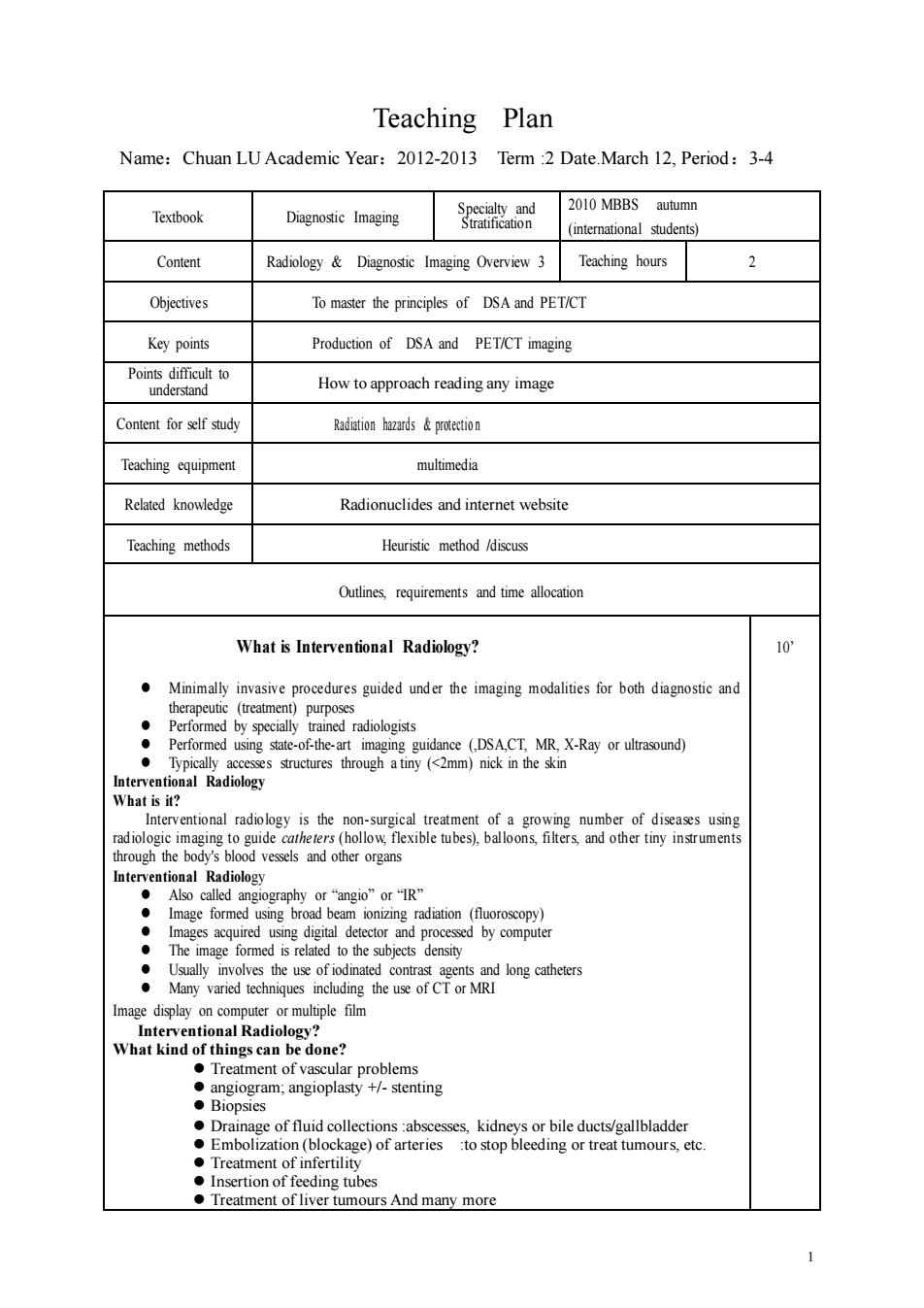
Teaching Plan Name:Chuan LU Academic Year:2012-2013 Term :2 Date.March 12,Period:3-4 Textbook ruo 2010 MBBS autumn ntemationalstudcen Content Radiology&Diagnostic Imaging Overview3 Teaching hours 2 Objectives To master the principles of DSA and PET/CT Key points Production of DSA and PET/CT imaging Po How to approach reading any image Content for self study Radition hazdsprotection Teaching equipment multimedia Related knowedge Radionuclides and internet website Teaching methods Heuristic method /discuss Outlines requirements and time allocation What is Interventional Radiology? 10 Minimally invasive procedures guided under the imaging modalities for both diagnostic and 氵ce(sC红RX海 radioogists structures through a tiny (<2mm)nick in the skin What is it? hthepoend oerr Mius including us of and ong catheters Image display on computer or multiple film of fluid collecti kidr Embolization(blockage)of bleeding or treat tumours.ete Treatment of liver tumours And many more
1 Teaching Plan Name:Chuan LU Academic Year:2012-2013 Term :2 Date.March 12, Period:3-4 Textbook Diagnostic Imaging Specialty and Stratification 2010 MBBS autumn (international students) Content Radiology & Diagnostic Imaging Overview 3 Teaching hours 2 Objectives To master the principles of DSA and PET/CT Key points Production of DSA and PET/CT imaging Points difficult to understand How to approach reading any image Content for self study Radiation hazards & protectio n Teaching equipment multimedia Related knowledge Radionuclides and internet website Teaching methods Heuristic method /discuss Outlines, requirements and time allocation What is Interventional Radiology? ⚫ Minimally invasive procedures guided und er the imaging modalities for both diagnostic and therapeutic (treatment) purposes ⚫ Performed by specially trained radiologists ⚫ Performed using state-of-the-art imaging guidance (,DSA,CT, MR, X-Ray or ultrasound) ⚫ Typically accesses structures through a tiny (<2mm) nick in the skin Interventional Radiology What is it? Interventional radiology is the non-surgical treatment of a growing number of diseases using radiologic imaging to guide catheters (hollow, flexible tubes), balloons, filters, and other tiny instruments through the body's blood vessels and other organs Interventional Radiology ⚫ Also called angiography or “angio” or “IR” ⚫ Image formed using broad beam ionizing radiation (fluoroscopy) ⚫ Images acquired using digital detector and processed by computer ⚫ The image formed is related to the subjects density ⚫ Usually involves the use of iodinated contrast agents and long catheters ⚫ Many varied techniques including the use of CT or MRI Image display on computer or multiple film Interventional Radiology? What kind of things can be done? ⚫ Treatment of vascular problems ⚫ angiogram; angioplasty +/- stenting ⚫ Biopsies ⚫ Drainage of fluid collections :abscesses, kidneys or bile ducts/gallbladder ⚫ Embolization (blockage) of arteries :to stop bleeding or treat tumours, etc. ⚫ Treatment of infertility ⚫ Insertion of feeding tubes ⚫ Treatment of liver tumours And many more 10’
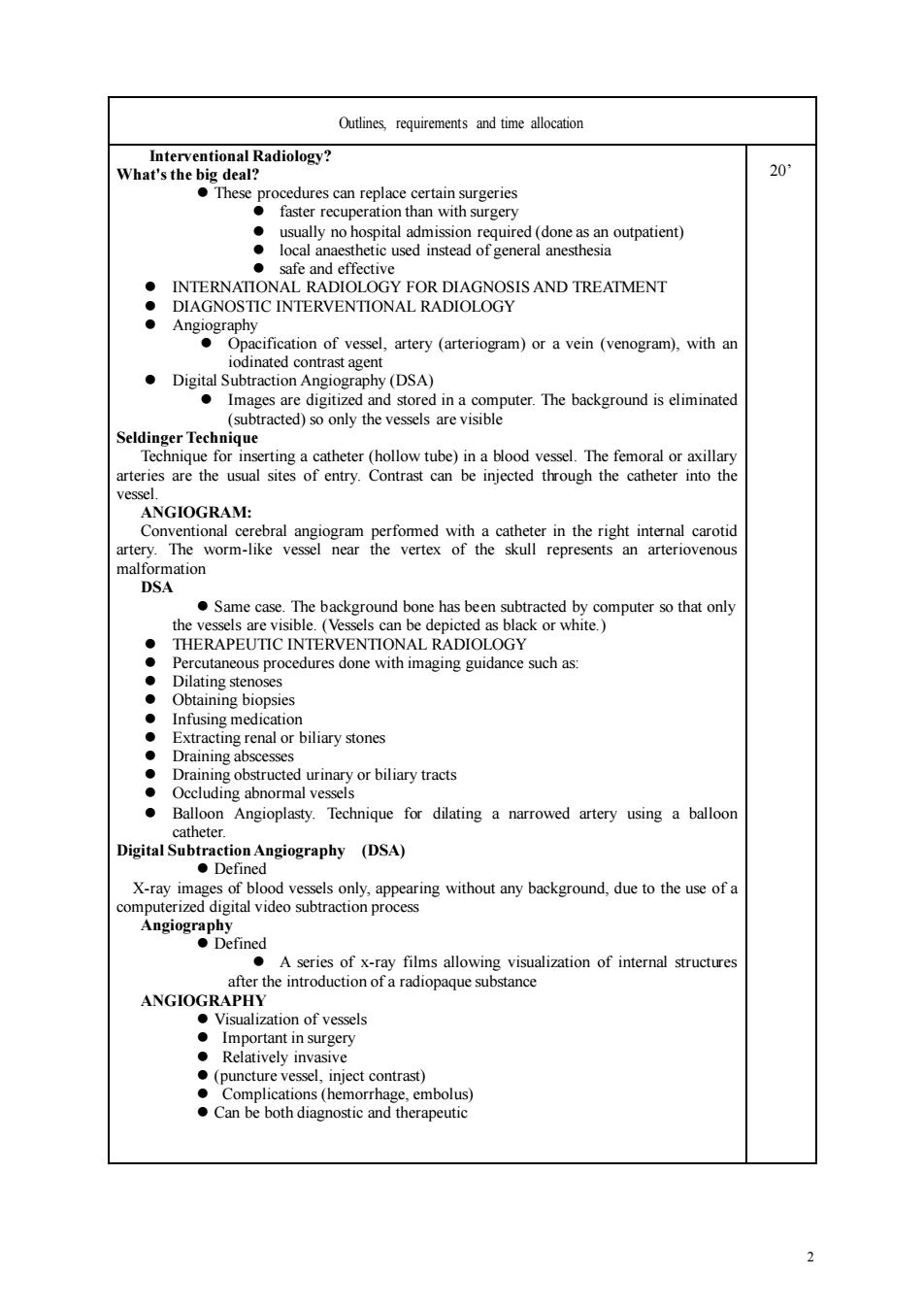
Outlines requirements and time allocation Interventional Radiology? What's the edures can renlace certain faster recuperation than with surgery ification of vessel.artery (artcriogram)or a vein (yenogram).with an Images are digitized and stored ina computer.The background is eliminated (subtracted)so only the vessels are visible iner (ol)Hod ve The mor arteries are the usual sites of entry.Contrast can be injected through the catheter into the ANGIOGRAM: represents an arteriovenous DSA d bone has be THERAPEUTIC INTERVENTIONAL RADIOLOGY eprodes one with imaging gudance suchas ● sies Draining Balloon Angioplasty.Technique for dilating a narrowed artery using a balloon mdwihout any background,u o theo ANGIOGRAPHY diopaque substanc
2 Outlines, requirements and time allocation Interventional Radiology? What's the big deal? ⚫ These procedures can replace certain surgeries ⚫ faster recuperation than with surgery ⚫ usually no hospital admission required (done as an outpatient) ⚫ local anaesthetic used instead of general anesthesia ⚫ safe and effective ⚫ INTERNATIONAL RADIOLOGY FOR DIAGNOSIS AND TREATMENT ⚫ DIAGNOSTIC INTERVENTIONAL RADIOLOGY ⚫ Angiography ⚫ Opacification of vessel, artery (arteriogram) or a vein (venogram), with an iodinated contrast agent ⚫ Digital Subtraction Angiography (DSA) ⚫ Images are digitized and stored in a computer. The background is eliminated (subtracted) so only the vessels are visible Seldinger Technique Technique for inserting a catheter (hollow tube) in a blood vessel. The femoral or axillary arteries are the usual sites of entry. Contrast can be injected through the catheter into the vessel. ANGIOGRAM: Conventional cerebral angiogram performed with a catheter in the right internal carotid artery. The worm-like vessel near the vertex of the skull represents an arteriovenous malformation DSA ⚫ Same case. The background bone has been subtracted by computer so that only the vessels are visible. (Vessels can be depicted as black or white.) ⚫ THERAPEUTIC INTERVENTIONAL RADIOLOGY ⚫ Percutaneous procedures done with imaging guidance such as: ⚫ Dilating stenoses ⚫ Obtaining biopsies ⚫ Infusing medication ⚫ Extracting renal or biliary stones ⚫ Draining abscesses ⚫ Draining obstructed urinary or biliary tracts ⚫ Occluding abnormal vessels ⚫ Balloon Angioplasty. Technique for dilating a narrowed artery using a balloon catheter. Digital Subtraction Angiography (DSA) ⚫ Defined X-ray images of blood vessels only, appearing without any background, due to the use of a computerized digital video subtraction process Angiography ⚫ Defined ⚫ A series of x-ray films allowing visualization of internal structures after the introduction of a radiopaque substance ANGIOGRAPHY ⚫ Visualization of vessels ⚫ Important in surgery ⚫ Relatively invasive ⚫ (puncture vessel, inject contrast) ⚫ Complications (hemorrhage, embolus) ⚫ Can be both diagnostic and therapeutic 20’
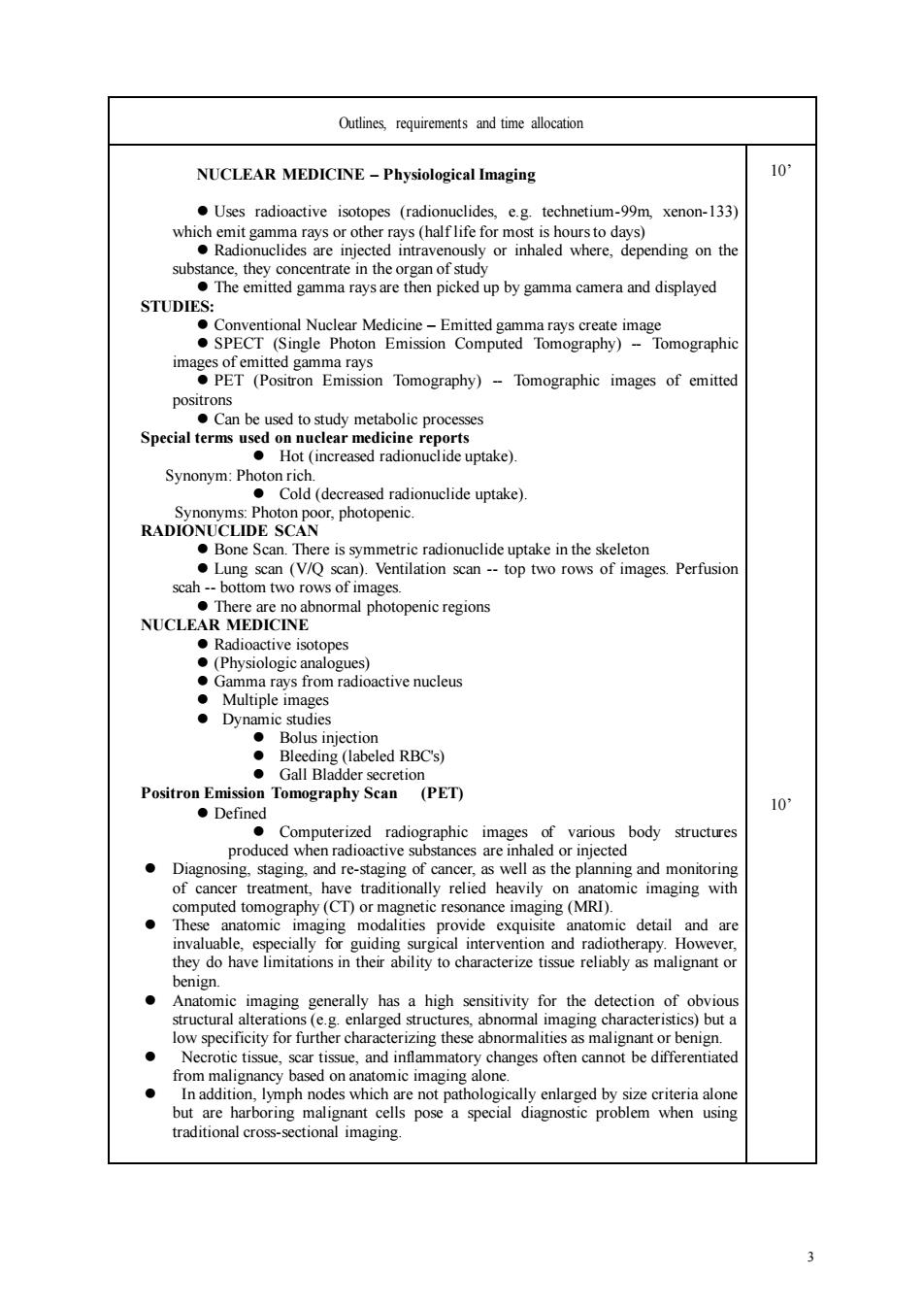
Outlines requirements and time allocation NUCLEAR MEDICINE-Physiological Imaging 0. Uses radioactive isotopes (radionuclides,e.g technetium-99m,xenon-133) substance.they concentrate in theorgn of stu nding on the STUDIES The emitted gamma rays are then picked up by gamma camera and displayed Conventional Nuclear Medicine-Emitted gamma rays create image SPECT (Single Photon Emission Computed Tomography)-Tomographic )Tomogaphiem ofem positrons Specialcrsnuaodemib Hot(increased radionuclide uptake). Synonym:Ph (uptake) etric radionuclide untake in the skeletor Lung scan (V/scan)Ventilation scantop two rows of images.Perfusion NUCLEAR MEDICINE penic regions Radioactive isopes (PET) ●Defined 10 radio of cancer.as well as the planning and monitoring of cancer treatment,have traditionally relied heavilyon videce ima nic detail and are for guiding Anatomic imaging generally has a high sensitivity for the detection of obvious structural alterati (e.g.enlarged structures,a bnomal imaging characterist cs)but a from maligna traditional cross-sectional imaging
3 Outlines, requirements and time allocation NUCLEAR MEDICINE – Physiological Imaging ⚫ Uses radioactive isotopes (radionuclides, e.g. technetium-99m, xenon-133) which emit gamma rays or other rays (half life for most is hours to days) ⚫ Radionuclides are injected intravenously or inhaled where, depending on the substance, they concentrate in the organ of study ⚫ The emitted gamma rays are then picked up by gamma camera and displayed STUDIES: ⚫ Conventional Nuclear Medicine – Emitted gamma rays create image ⚫ SPECT (Single Photon Emission Computed Tomography) - Tomographic images of emitted gamma rays ⚫ PET (Positron Emission Tomography) - Tomographic images of emitted positrons ⚫ Can be used to study metabolic processes Special terms used on nuclear medicine reports ⚫ Hot (increased radionuclide uptake). Synonym: Photon rich. ⚫ Cold (decreased radionuclide uptake). Synonyms: Photon poor, photopenic. RADIONUCLIDE SCAN ⚫ Bone Scan. There is symmetric radionuclide uptake in the skeleton ⚫ Lung scan (V/Q scan). Ventilation scan - top two rows of images. Perfusion scah - bottom two rows of images. ⚫ There are no abnormal photopenic regions NUCLEAR MEDICINE ⚫ Radioactive isotopes ⚫ (Physiologic analogues) ⚫ Gamma rays from radioactive nucleus ⚫ Multiple images ⚫ Dynamic studies ⚫ Bolus injection ⚫ Bleeding (labeled RBC's) ⚫ Gall Bladder secretion Positron Emission Tomography Scan (PET) ⚫ Defined ⚫ Computerized radiographic images of various body structures produced when radioactive substances are inhaled or injected ⚫ Diagnosing, staging, and re-staging of cancer, as well as the planning and monitoring of cancer treatment, have traditionally relied heavily on anatomic imaging with computed tomography (CT) or magnetic resonance imaging (MRI). ⚫ These anatomic imaging modalities provide exquisite anatomic detail and are invaluable, especially for guiding surgical intervention and radiotherapy. However, they do have limitations in their ability to characterize tissue reliably as malignant or benign. ⚫ Anatomic imaging generally has a high sensitivity for the detection of obvious structural alterations (e.g. enlarged structures, abnormal imaging characteristics) but a low specificity for further characterizing these abnormalities as malignant or benign. ⚫ Necrotic tissue, scar tissue, and inflammatory changes often cannot be differentiated from malignancy based on anatomic imaging alone. ⚫ In addition, lymph nodes which are not pathologically enlarged by size criteria alone but are harboring malignant cells pose a special diagnostic problem when using traditional cross-sectional imaging. 10’ 10’
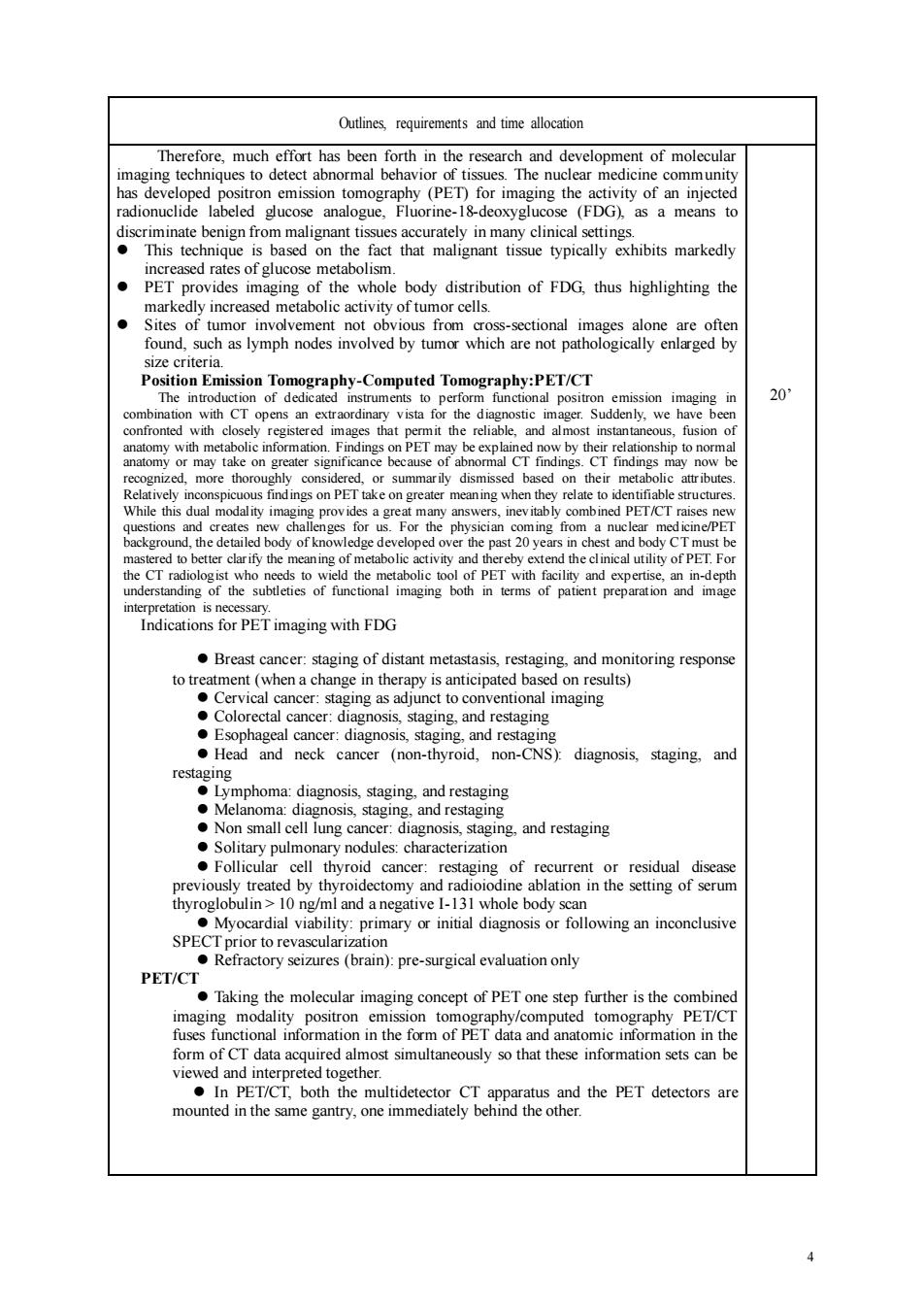
Outlines requirements and time allocation Therefore.much effort has been forth in the research and development of molecular abnormal The nu ear medicir ne community radionuclid labeloue-(FDmean PEprovid minfthehbodyisribution of FG thus highlighting the poies involyed by tumor which ar o o alone are ofte 20 on grea or on their ●Breas过cancer staging of distant metastasis .and monitoring response to treatment (when a change in therapy is anticipated based on) Head and neck cancer (non-thyroid,non-CNS diagnosis,staging.and mphoma diagnosis staging and restagins .and restaging ●on sma larCCrdenoiaene、andrctaeng Follicular cell thyroid cancer:restaging of recurrent or residual diseas ablation in the setting of serum Myocardial viability:primary or initial diagnosis or following an inconclusive PET/CT Taking the molecular imaging conept of PETone step further is the combined form ofCT data acquired almost simultaneously so that these information sets can be
4 Outlines, requirements and time allocation Therefore, much effort has been forth in the research and development of molecular imaging techniques to detect abnormal behavior of tissues. The nuclear medicine community has developed positron emission tomography (PET) for imaging the activity of an injected radionuclide labeled glucose analogue, Fluorine-18-deoxyglucose (FDG), as a means to discriminate benign from malignant tissues accurately in many clinical settings. ⚫ This technique is based on the fact that malignant tissue typically exhibits markedly increased rates of glucose metabolism. ⚫ PET provides imaging of the whole body distribution of FDG, thus highlighting the markedly increased metabolic activity of tumor cells. ⚫ Sites of tumor involvement not obvious from cross-sectional images alone are often found, such as lymph nodes involved by tumor which are not pathologically enlarged by size criteria. Position Emission Tomography-Computed Tomography:PET/CT The introduction of dedicated instruments to perform functional positron emission imaging in combination with CT opens an extraordinary vista for the diagnostic imager. Suddenly, we have been confronted with closely registered images that permit the reliable, and almost instantaneous, fusion of anatomy with metabolic information. Findings on PET may be explained now by their relationship to normal anatomy or may take on greater significance because of abnormal CT findings. CT findings may now be recognized, more thoroughly considered, or summarily dismissed based on their metabolic attributes. Relatively inconspicuous findings on PET take on greater meaning when they relate to identifiable structures. While this dual modality imaging provides a great many answers, inevitably combined PET/CT raises new questions and creates new challenges for us. For the physician coming from a nuclear medicine/PET background, the detailed body of knowledge developed over the past 20 years in chest and body CT must be mastered to better clarify the meaning of metabolic activity and thereby extend the clinical utility of PET. For the CT radiologist who needs to wield the metabolic tool of PET with facility and expertise, an in-depth understanding of the subtleties of functional imaging both in terms of patient preparation and image interpretation is necessary. Indications for PET imaging with FDG ⚫ Breast cancer: staging of distant metastasis, restaging, and monitoring response to treatment (when a change in therapy is anticipated based on results) ⚫ Cervical cancer: staging as adjunct to conventional imaging ⚫ Colorectal cancer: diagnosis, staging, and restaging ⚫ Esophageal cancer: diagnosis, staging, and restaging ⚫ Head and neck cancer (non-thyroid, non-CNS): diagnosis, staging, and restaging ⚫ Lymphoma: diagnosis, staging, and restaging ⚫ Melanoma: diagnosis, staging, and restaging ⚫ Non small cell lung cancer: diagnosis, staging, and restaging ⚫ Solitary pulmonary nodules: characterization ⚫ Follicular cell thyroid cancer: restaging of recurrent or residual disease previously treated by thyroidectomy and radioiodine ablation in the setting of serum thyroglobulin > 10 ng/ml and a negative I-131 whole body scan ⚫ Myocardial viability: primary or initial diagnosis or following an inconclusive SPECT prior to revascularization ⚫ Refractory seizures (brain): pre-surgical evaluation only PET/CT ⚫ Taking the molecular imaging concept of PET one step further is the combined imaging modality positron emission tomography/computed tomography PET/CT fuses functional information in the form of PET data and anatomic information in the form of CT data acquired almost simultaneously so that these information sets can be viewed and interpreted together. ⚫ In PET/CT, both the multidetector CT apparatus and the PET detectors are mounted in the same gantry, one immediately behind the other. 20’
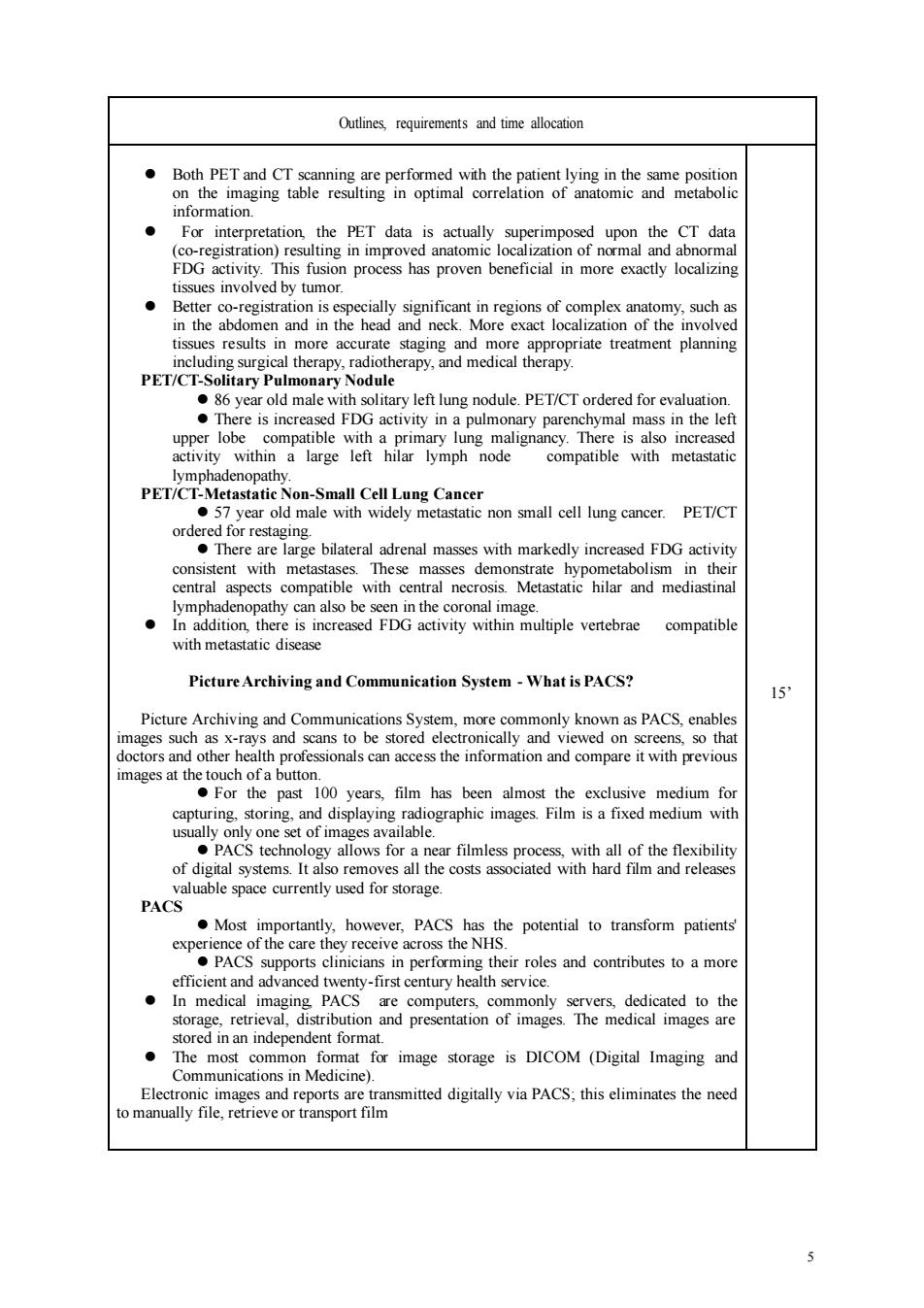
Outlines requirements and time allocation information. d by tumor. PETC-Solita Pumy Nodule apy 6yearold male with solitary left lung nodule.PET/CTordered for evaluation. yth lehlar ymph nod compatible with metastatic PETCI-Metae Non-Small Ce Cancer 57 year old male with widely metastatic non small cell lung cancer.PET/CT e hilateral adrenal masses with markedly ing d enG activit These masses demons strate hypometabolism in thei central aspects compa tible with central necrosis.Metastatic hilar and mediastinal compatible with metastatic disease Picture Archiving and Communication System-What is PACS? 15 Picture Archiving and Commun ns Sys sm.mre comm as PACS,enable dorand tr pronthe infoionmrth ton 00 vears film has been ium fo P pcecuremlye effici ●n medical ima are computers,commonly servers,dedicated to the and presentation of images.The medical The most common fommat for image storage is DICOM (Digital Imaging and Communi ations in Medicine) smitted digitally via PACS.the nee
5 Outlines, requirements and time allocation ⚫ Both PET and CT scanning are performed with the patient lying in the same position on the imaging table resulting in optimal correlation of anatomic and metabolic information. ⚫ For interpretation, the PET data is actually superimposed upon the CT data (co-registration) resulting in improved anatomic localization of normal and abnormal FDG activity. This fusion process has proven beneficial in more exactly localizing tissues involved by tumor. ⚫ Better co-registration is especially significant in regions of complex anatomy, such as in the abdomen and in the head and neck. More exact localization of the involved tissues results in more accurate staging and more appropriate treatment planning including surgical therapy, radiotherapy, and medical therapy. PET/CT-Solitary Pulmonary Nodule ⚫ 86 year old male with solitary left lung nodule. PET/CT ordered for evaluation. ⚫ There is increased FDG activity in a pulmonary parenchymal mass in the left upper lobe compatible with a primary lung malignancy. There is also increased activity within a large left hilar lymph node compatible with metastatic lymphadenopathy. PET/CT-Metastatic Non-Small Cell Lung Cancer ⚫ 57 year old male with widely metastatic non small cell lung cancer. PET/CT ordered for restaging. ⚫ There are large bilateral adrenal masses with markedly increased FDG activity consistent with metastases. These masses demonstrate hypometabolism in their central aspects compatible with central necrosis. Metastatic hilar and mediastinal lymphadenopathy can also be seen in the coronal image. ⚫ In addition, there is increased FDG activity within multiple vertebrae compatible with metastatic disease Picture Archiving and Communication System - What is PACS? Picture Archiving and Communications System, more commonly known as PACS, enables images such as x-rays and scans to be stored electronically and viewed on screens, so that doctors and other health professionals can access the information and compare it with previous images at the touch of a button. ⚫ For the past 100 years, film has been almost the exclusive medium for capturing, storing, and displaying radiographic images. Film is a fixed medium with usually only one set of images available. ⚫ PACS technology allows for a near filmless process, with all of the flexibility of digital systems. It also removes all the costs associated with hard film and releases valuable space currently used for storage. PACS ⚫ Most importantly, however, PACS has the potential to transform patients' experience of the care they receive across the NHS. ⚫ PACS supports clinicians in performing their roles and contributes to a more efficient and advanced twenty-first century health service. ⚫ In medical imaging, PACS are computers, commonly servers, dedicated to the storage, retrieval, distribution and presentation of images. The medical images are stored in an independent format. ⚫ The most common format for image storage is DICOM (Digital Imaging and Communications in Medicine). Electronic images and reports are transmitted digitally via PACS; this eliminates the need to manually file, retrieve or transport film 15’
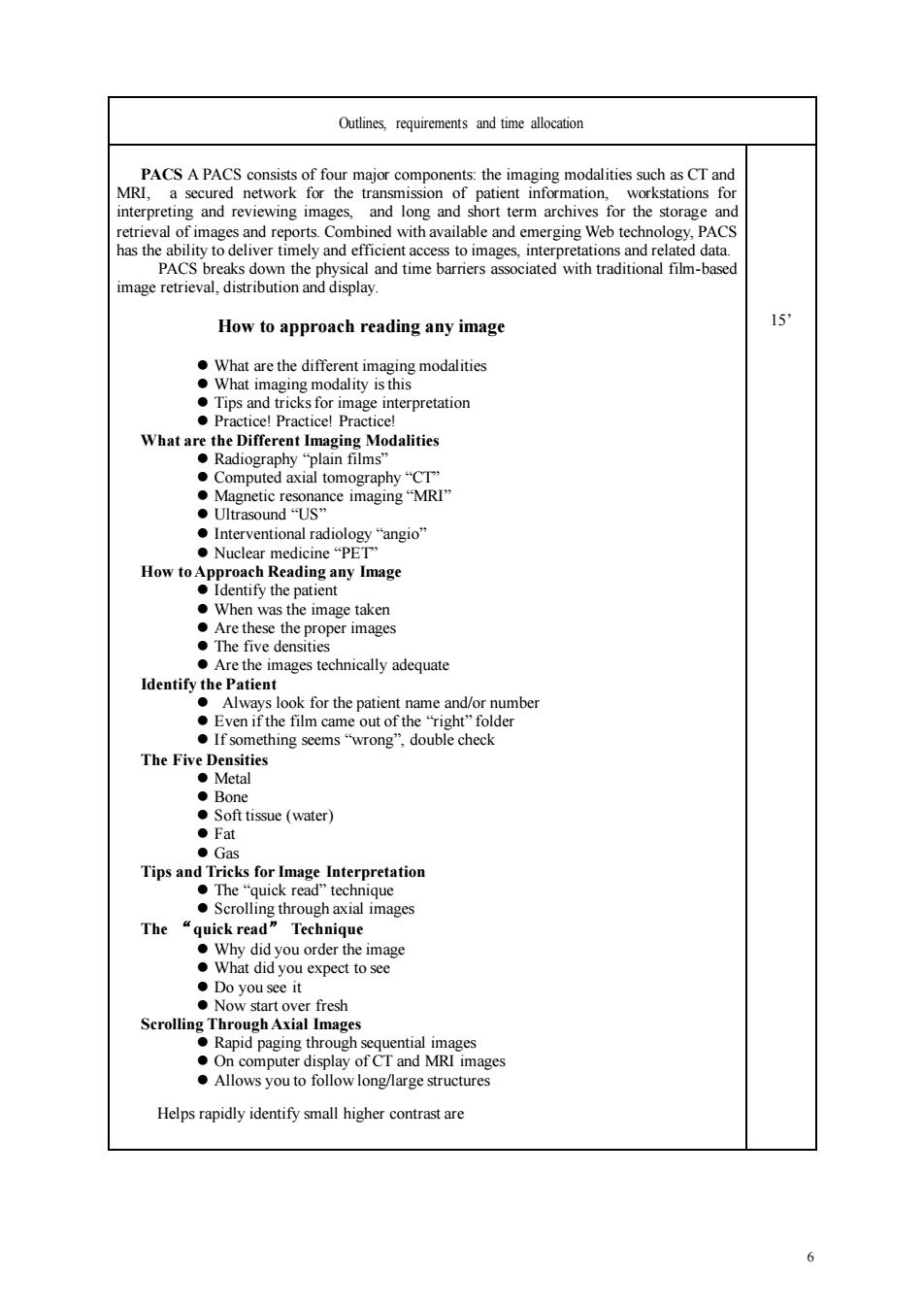
Outlines requirements and time allocation PACSAPACS interpreting and reviewing images and long and short term archives for the storage and ielofWsindreportsC ned with available and emerging Web technology.PA PACS preaks down the ph mage retreval,istrbutionanddispay. How to approach reading any image 15 What are the different imaging modalities Computed Interventional radiology"angio" 。Nucear medicine"PET When was the image taken The proper images Are the images technically adequate look for the patient name and/or Even if the film cameou of the tissue (water) ●Fat Tips and The ngthrough axial imags Tec nique ●Do you see it Scrolling Thr ouhAxial Image struct mage Helps rapidly identify small
6 Outlines, requirements and time allocation PACS A PACS consists of four major components: the imaging modalities such as CT and MRI, a secured network for the transmission of patient information, workstations for interpreting and reviewing images, and long and short term archives for the storage and retrieval of images and reports. Combined with available and emerging Web technology, PACS has the ability to deliver timely and efficient access to images, interpretations and related data. PACS breaks down the physical and time barriers associated with traditional film-based image retrieval, distribution and display. How to approach reading any image ⚫ What are the different imaging modalities ⚫ What imaging modality is this ⚫ Tips and tricks for image interpretation ⚫ Practice! Practice! Practice! What are the Different Imaging Modalities ⚫ Radiography “plain films” ⚫ Computed axial tomography “CT” ⚫ Magnetic resonance imaging “MRI” ⚫ Ultrasound “US” ⚫ Interventional radiology “angio” ⚫ Nuclear medicine “PET” How to Approach Reading any Image ⚫ Identify the patient ⚫ When was the image taken ⚫ Are these the proper images ⚫ The five densities ⚫ Are the images technically adequate Identify the Patient ⚫ Always look for the patient name and/or number ⚫ Even if the film came out of the “right” folder ⚫ If something seems “wrong”, double check The Five Densities ⚫ Metal ⚫ Bone ⚫ Soft tissue (water) ⚫ Fat ⚫ Gas Tips and Tricks for Image Interpretation ⚫ The “quick read” technique ⚫ Scrolling through axial images The “quick read” Technique ⚫ Why did you order the image ⚫ What did you expect to see ⚫ Do you see it ⚫ Now start over fresh Scrolling Through Axial Images ⚫ Rapid paging through sequential images ⚫ On computer display of CT and MRI images ⚫ Allows you to follow long/large structures Helps rapidly identify small higher contrast are 15’

Outlines requirements and time allocation ●Size /Intensity/Echogenicity ROLE OF RADIOLOGIST dentify abnormality (NI or Abnl) Differential diagnosis ROLE OF CLINICIANG er work up ●Relevant history Treat or refer patient 1
7 Outlines, requirements and time allocation BASIC RADIOLOGIC SIGNS ⚫ Position ⚫ Size ⚫ Number ⚫ Density/Intensity/Echogenicity ⚫ Shape ⚫ Architecture/Texture ⚫ Function ROLE OF RADIOLOGIST ⚫ Identify abnormality (Nl or Abnl) ⚫ Characterize abnormality ⚫ Extent of disease (Staging) ⚫ Differential diagnosis ⚫ Suggest further work up ROLE OF CLINICIAN ⚫ Relevant history ⚫ Consult with radiologist ⚫ Pursue further work up ⚫ Treat or refer patient